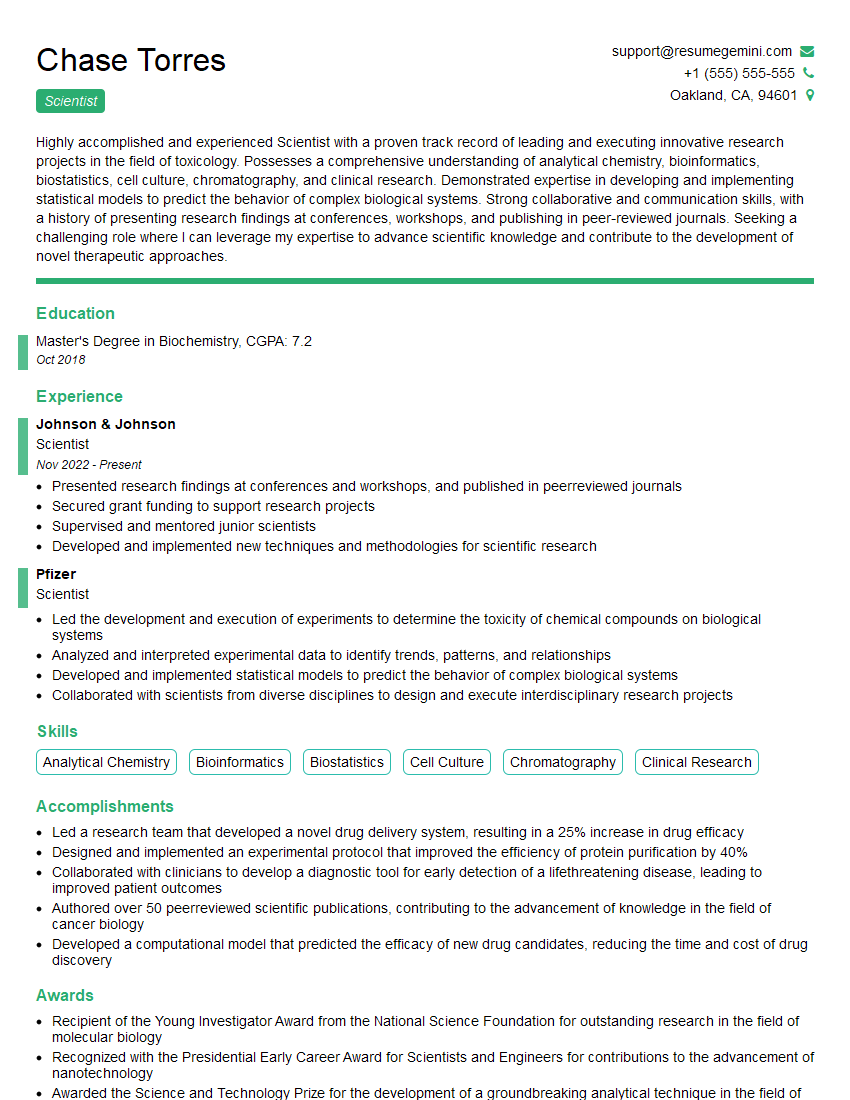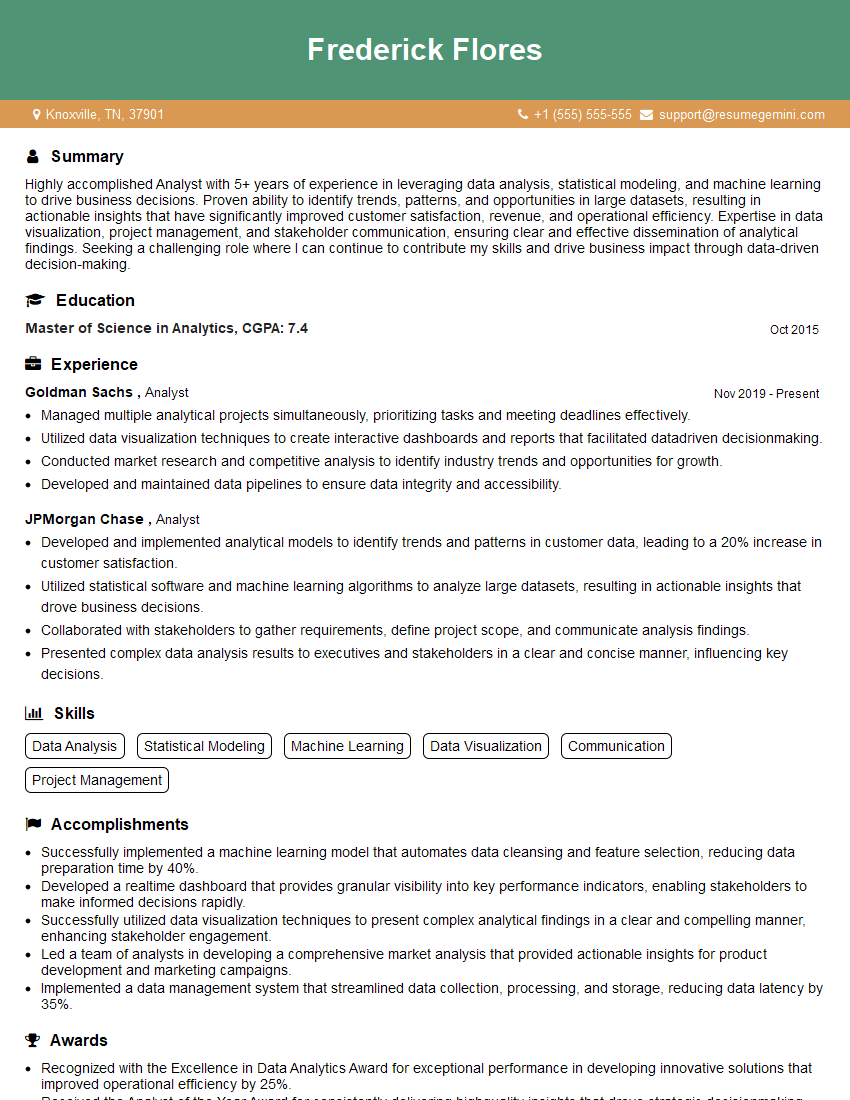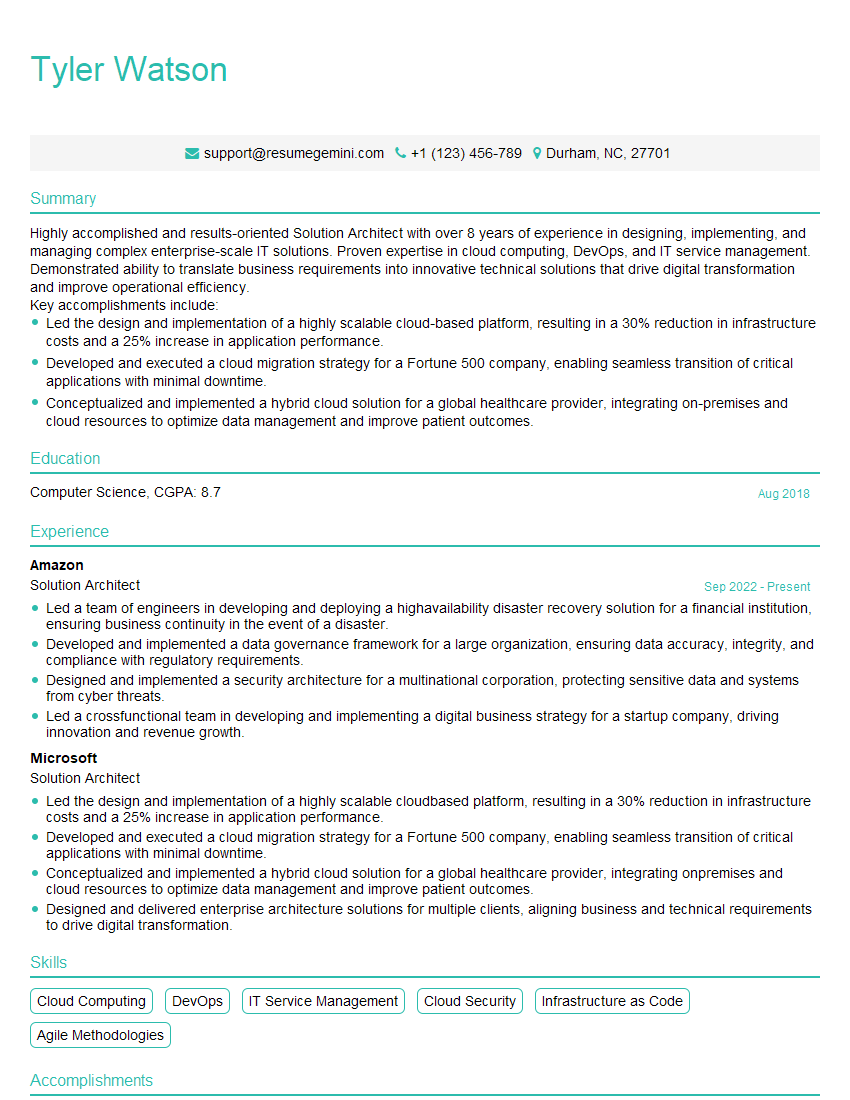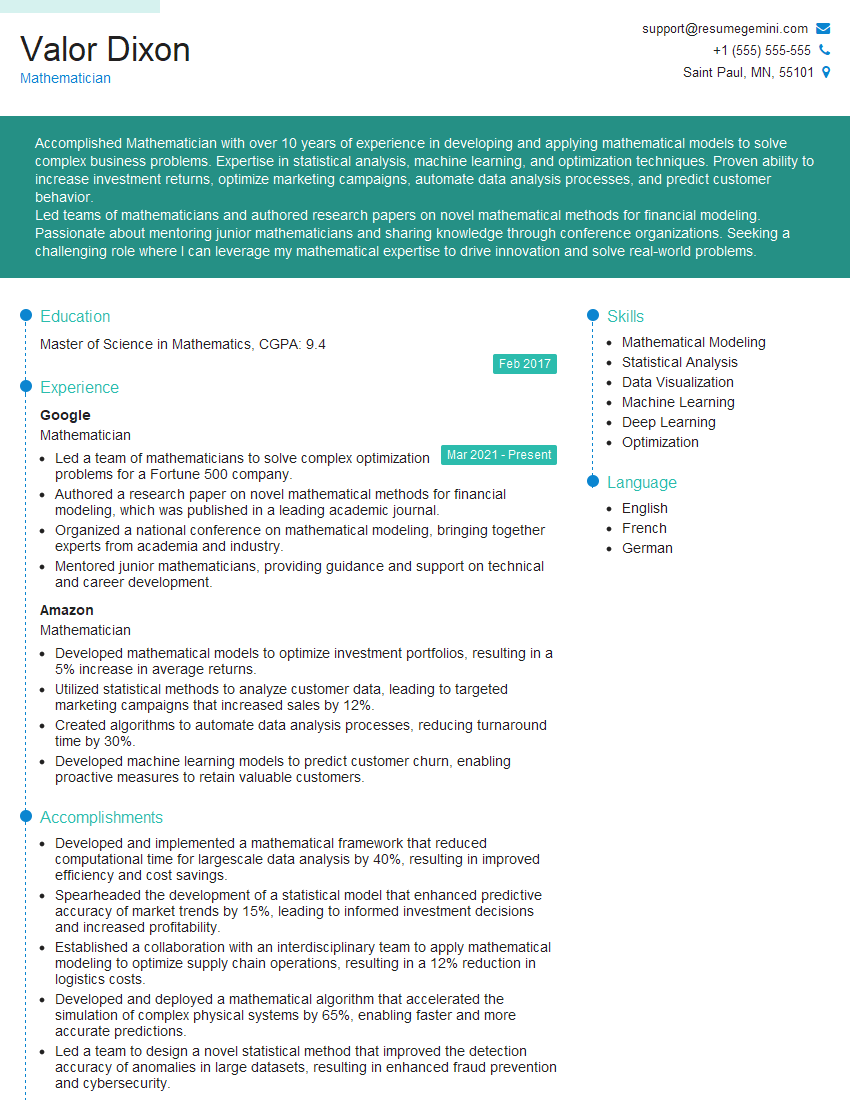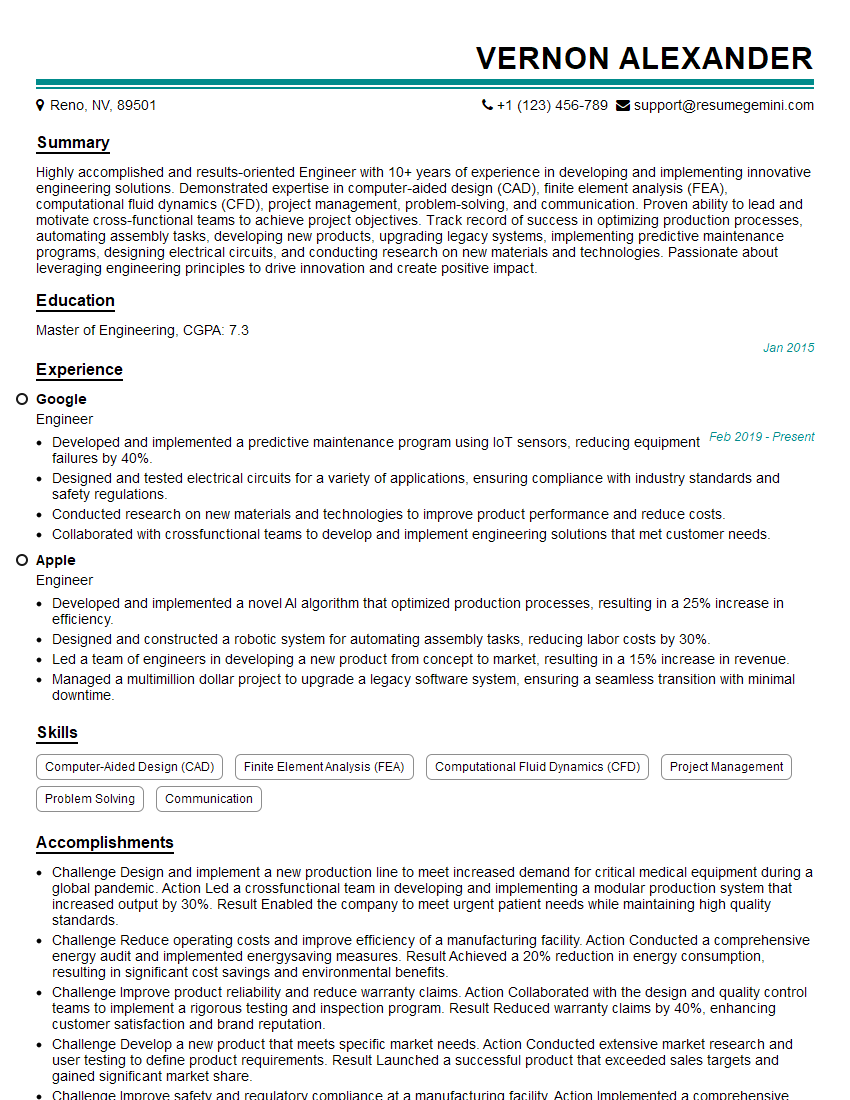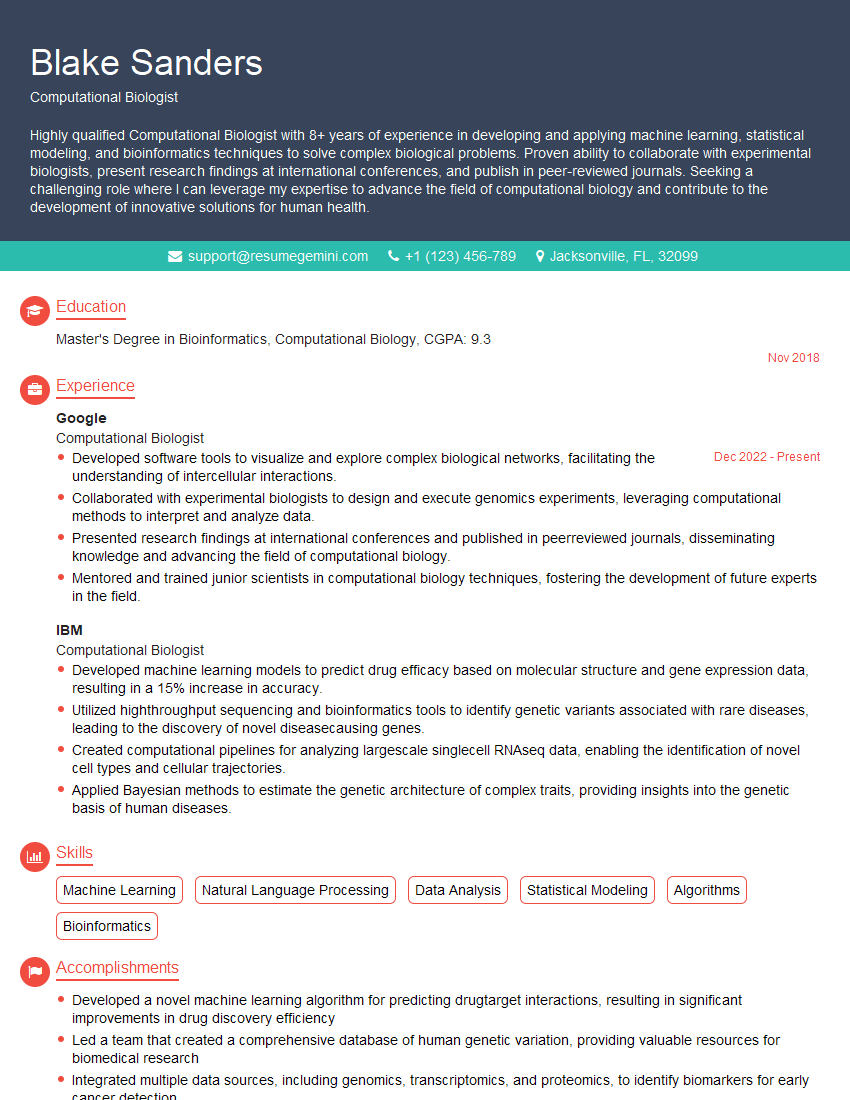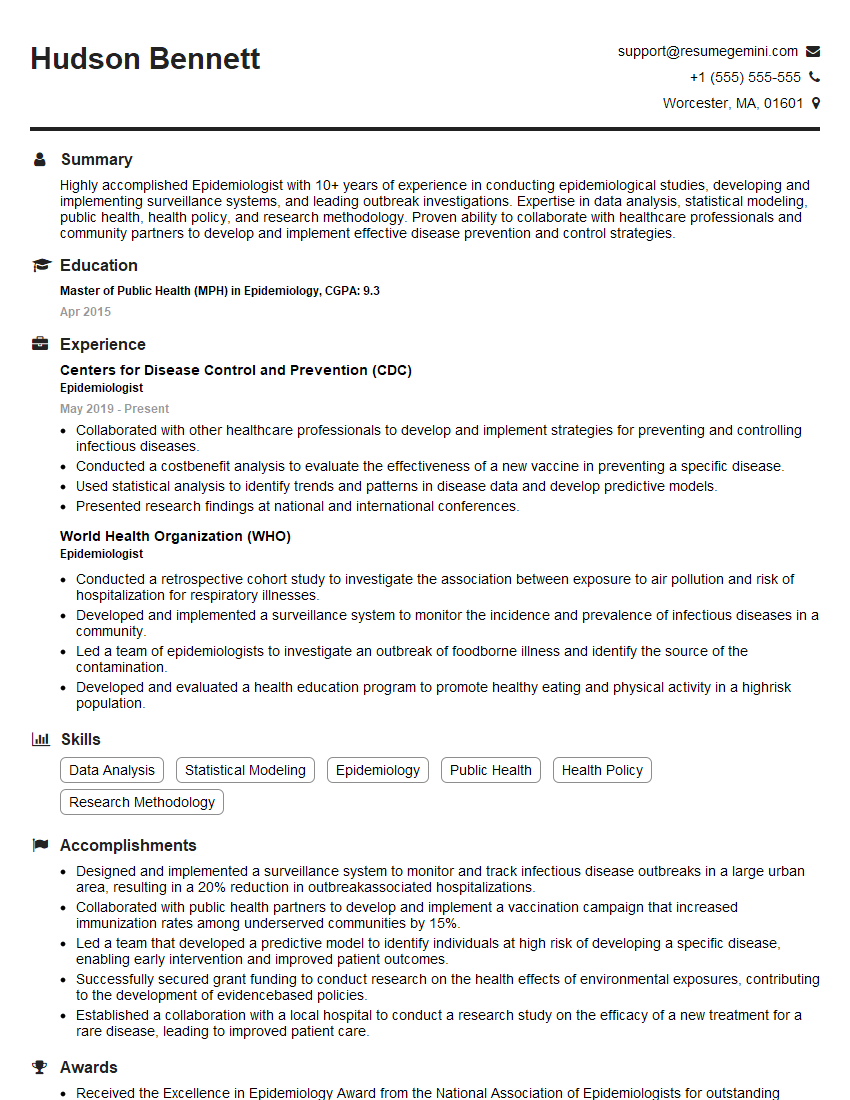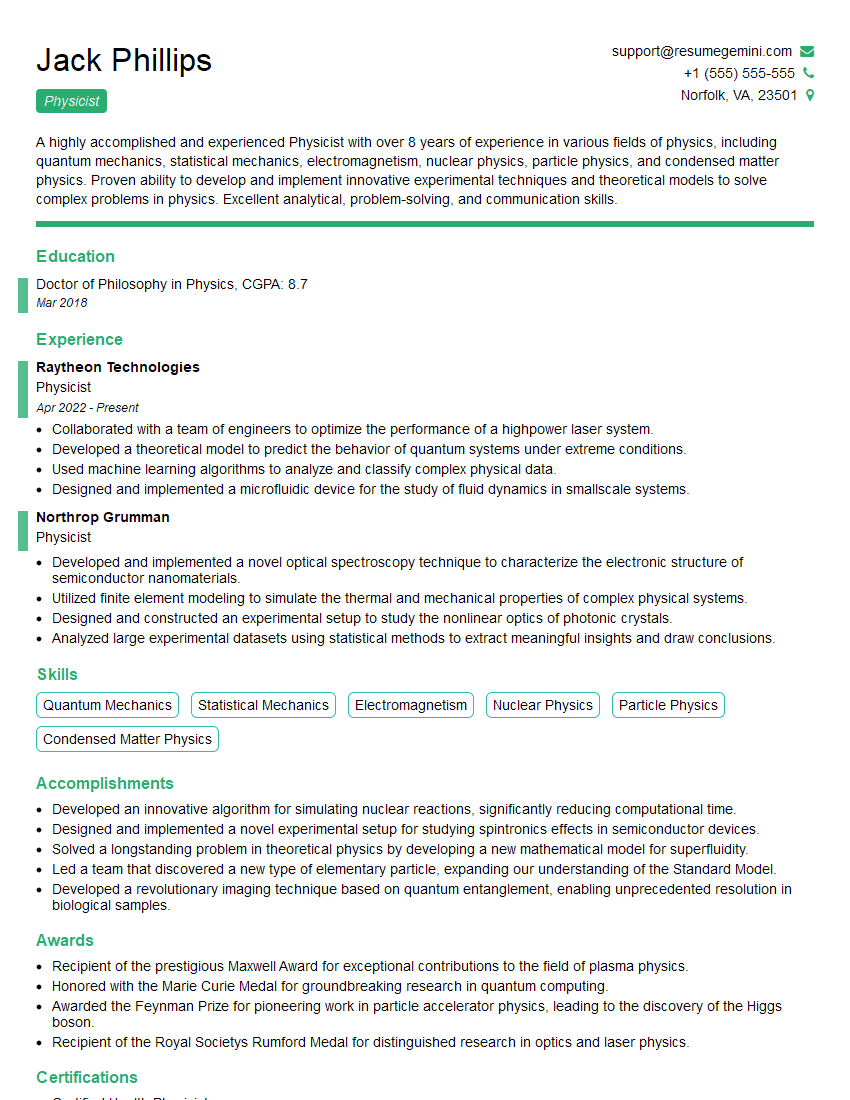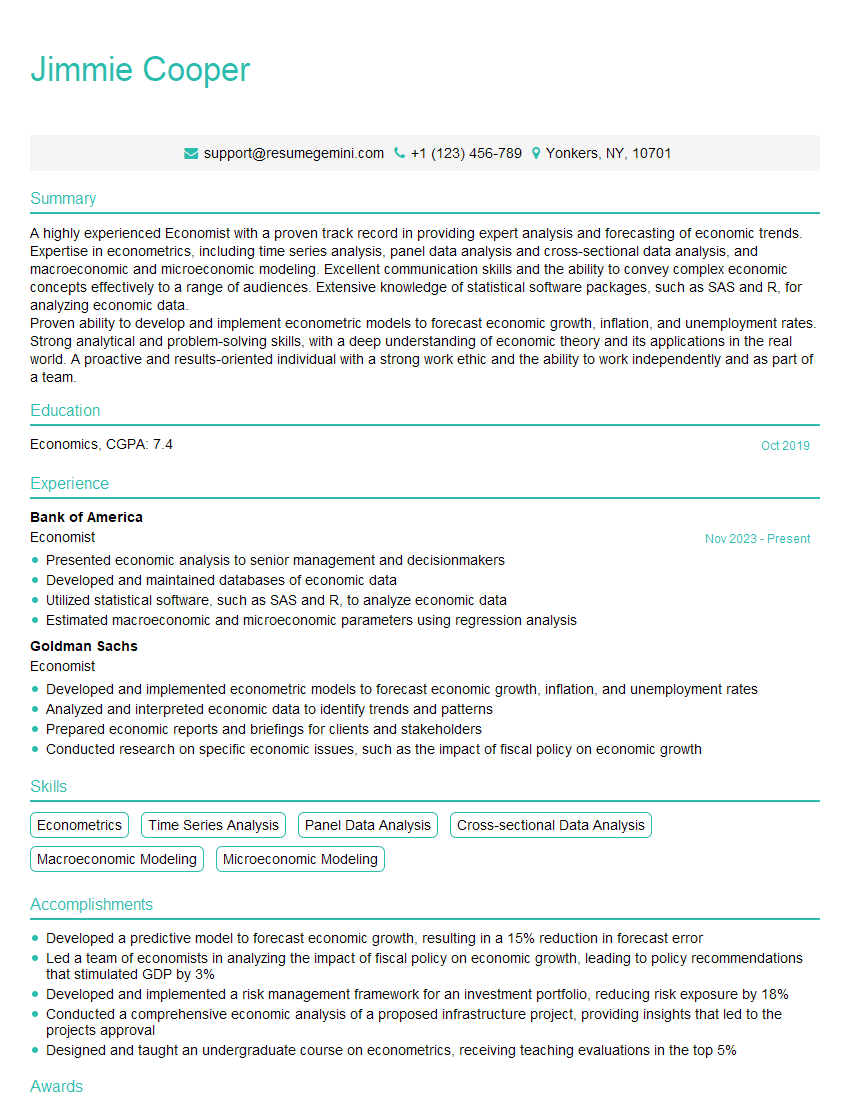The thought of an interview can be nerve-wracking, but the right preparation can make all the difference. Explore this comprehensive guide to Sample Problem Solving interview questions and gain the confidence you need to showcase your abilities and secure the role.
Questions Asked in Sample Problem Solving Interview
Q 1. Explain your approach to solving a sample problem, step-by-step.
My approach to solving sample problems is systematic and iterative. I believe in a structured methodology to ensure thoroughness and accuracy. It involves these key steps:
- Understanding the Problem: This initial phase involves carefully reading the problem statement multiple times, identifying the key objectives, and clarifying any ambiguous terms. I often visualize the problem using diagrams or sketches to grasp the overall picture.
- Defining Inputs and Outputs: I explicitly define the inputs required to solve the problem and the expected outputs or results. This helps in focusing my efforts and defining the scope of the solution.
- Developing a Solution Strategy: This step involves choosing an appropriate algorithm or methodology based on the problem’s nature and complexity. I consider factors like efficiency, scalability, and maintainability. Sometimes, a simple approach is sufficient, while others might require more complex algorithms or techniques.
- Implementing the Solution: I translate the chosen strategy into code or a detailed step-by-step solution. I prioritize writing clean, well-documented code for better understanding and debugging.
- Testing and Verification: Thorough testing is crucial. I use various test cases, including edge cases and boundary conditions, to verify the solution’s correctness. I also incorporate debugging techniques to identify and resolve any errors.
- Refining and Optimizing: Once the solution is working, I review it for potential improvements in terms of efficiency, readability, or robustness. This iterative process often leads to a more polished and effective solution.
For example, if presented with a sample problem that involves finding the shortest path between two points on a map, I’d use a graph-based algorithm like Dijkstra’s algorithm, testing with various map layouts and edge cases, including disconnected nodes and negative edge weights.
Q 2. How do you identify assumptions in a sample problem?
Identifying assumptions is crucial for accurate problem-solving. Assumptions are often implicit statements or beliefs that are taken for granted but can significantly impact the solution. I actively look for assumptions by asking questions like:
- What information is not explicitly provided? The absence of information can indicate implicit assumptions.
- What are the limitations or constraints of the problem? These limitations often reflect underlying assumptions.
- Are there any simplifications or generalizations made in the problem statement? These represent assumptions that might need further scrutiny.
- What are the expected characteristics of the inputs? For instance, if a problem deals with numbers, is it assumed they are integers, real numbers, or within a specific range?
For instance, in a problem involving calculating the average speed of a vehicle, an assumption might be that the vehicle travels at a constant speed. Clearly stating and validating assumptions helps prevent errors and ensures the solution’s accuracy and reliability.
Q 3. Describe a time you encountered a sample problem with incomplete data. How did you proceed?
In a previous project involving optimizing warehouse logistics, I encountered incomplete data regarding delivery times for certain regions. I couldn’t simply ignore the missing data; it would have skewed the optimization results. My approach involved:
- Data Exploration: I first analyzed the existing data to understand the distribution and patterns of the available delivery times.
- Imputation Techniques: I explored different imputation methods to estimate the missing values. This included using statistical techniques like mean, median, or mode imputation or more advanced methods like K-Nearest Neighbors (KNN) imputation, which considered similar regions’ delivery times.
- Sensitivity Analysis: To assess the impact of the imputation methods on the overall optimization, I conducted a sensitivity analysis. I tested multiple imputation techniques and compared the resulting optimization solutions to determine the robustness of the results.
- Documentation: I clearly documented the data imputation techniques and their limitations. This transparency ensured that the impact of incomplete data on the final results was fully understood.
While the imputed values weren’t perfect, this approach allowed me to proceed with the optimization, providing valuable insights while acknowledging the inherent uncertainties due to missing data.
Q 4. What strategies do you use to break down complex sample problems into smaller, manageable parts?
Breaking down complex problems into smaller, manageable parts is crucial for effective problem-solving. I use several strategies:
- Divide and Conquer: I decompose the problem into smaller, independent subproblems. Each subproblem is then solved individually, and the solutions are combined to produce the overall solution.
- Top-Down Approach: I start with a high-level overview of the problem and break it down into progressively smaller, more specific tasks. This approach helps in establishing a clear hierarchy of tasks and dependencies.
- Bottom-Up Approach: I begin by identifying the fundamental components or modules of the problem and then gradually integrate them to solve the larger problem. This works well when the problem has well-defined building blocks.
- Abstraction: I focus on the essential aspects of the problem while hiding unnecessary details. This helps in managing complexity and focusing on the core issues.
For example, developing a software application involves breaking it down into modules like user interface, database interaction, and business logic. Each module can then be further decomposed into smaller units of code for easier development and maintenance.
Q 5. How do you verify the accuracy of your solution to a sample problem?
Verifying the accuracy of a solution is a critical step. I employ several methods:
- Unit Testing: I test individual components or modules of the solution to ensure that they function correctly. Unit tests ensure that each part works as expected before integrating them.
- Integration Testing: After combining the individual modules, I perform integration tests to verify that they interact correctly and produce the desired output.
- System Testing: Once the entire system is integrated, I conduct system testing to evaluate its performance under various conditions and ensure it meets all requirements.
- Test-Driven Development (TDD): In some cases, I use TDD, where tests are written before the code. This helps in ensuring that the code meets the specified requirements and reduces the likelihood of errors.
- Manual Verification: For smaller problems or when appropriate, I manually check the solution’s results against expected values or use alternative methods to cross-verify the results.
For a mathematical problem, I might verify the solution using different approaches or by checking against known solutions or formulas.
Q 6. Explain your understanding of different problem-solving methodologies (e.g., top-down, bottom-up).
Understanding problem-solving methodologies is key to choosing the right approach.
- Top-Down Approach: This starts with a high-level view of the problem. The problem is broken down into smaller sub-problems, which are further divided until they’re simple enough to solve directly. This is like building a house – you start with the architectural plan and then focus on individual rooms, walls, and finally bricks.
- Bottom-Up Approach: This starts with the individual components of the problem and builds up toward a solution. This approach is better for problems where the solution can be constructed from well-defined building blocks. Think of assembling a Lego model—you start with individual bricks and combine them to create larger structures.
The choice between top-down and bottom-up depends on the nature of the problem. A top-down approach is suitable for complex problems where a clear overview is essential, while a bottom-up approach works well for problems with well-defined components. Many problems benefit from a hybrid approach, combining elements of both methodologies.
Q 7. How do you handle ambiguity when presented with a sample problem?
Ambiguity in sample problems is a common challenge. My approach involves:
- Clarification: I actively seek clarification on ambiguous aspects of the problem. This often involves asking clarifying questions to the problem’s presenter or referring to relevant documentation or standards.
- Assumption Listing: I explicitly list any assumptions I have to make to proceed in the absence of clear information. This transparency ensures that my solution’s limitations are understood.
- Sensitivity Analysis: If multiple interpretations are possible, I explore different scenarios based on each interpretation and evaluate the impact of these interpretations on the final solution. This helps to understand the solution’s sensitivity to the ambiguity.
- Robustness: I strive to develop a solution that is robust enough to handle variations in interpretation or input data. This is often achieved through defensive programming techniques.
For example, if a problem refers to ‘a large dataset’ without specifying the size, I would explore different scenarios assuming varying dataset sizes and assess the impact on the algorithm’s efficiency and memory consumption.
Q 8. Describe a time you had to adapt your approach to solving a sample problem mid-process.
Adaptability is crucial in problem-solving. Imagine you’re building a model airplane, and your initial design, relying on readily available materials, proves unstable. Mid-process, I’d recognize the flaw and adapt. This might involve researching alternative materials with better structural properties, adjusting the design based on aerodynamic principles, or even consulting relevant engineering guides. In a data science project, I might initially opt for a linear regression model, but if the data shows non-linear relationships, I’d shift to a more suitable algorithm like a support vector machine or a decision tree. The key is to acknowledge that initial assumptions may be wrong and to have the flexibility to adjust my approach based on evidence and analysis.
For example, during a recent project involving optimizing a delivery route, I initially used a greedy algorithm. However, I realized it wasn’t accounting for traffic patterns which significantly impacted delivery times. I adapted to a more sophisticated approach incorporating real-time traffic data and Dijkstra’s algorithm for pathfinding, significantly improving the solution.
Q 9. How do you prioritize tasks when working on a complex sample problem with multiple components?
Prioritization in complex problems is essential. I typically employ a combination of techniques. Firstly, I break down the problem into smaller, manageable components. Then, I use a prioritization matrix, considering factors like urgency, impact, and dependencies. Tasks with high urgency and high impact are tackled first. Dependencies are also critical; tasks that are prerequisites for others are prioritized accordingly. Visual tools like Kanban boards or Gantt charts can be incredibly useful in tracking progress and identifying potential bottlenecks. Finally, regular review and adjustment are crucial – I might need to re-prioritize based on new information or unforeseen challenges.
For instance, in developing a software application, features crucial for the minimum viable product (MVP) are prioritized over less critical functionalities. This ensures a faster time to market and allows for iterative development based on user feedback.
Q 10. How do you effectively communicate the solution to a sample problem to both technical and non-technical audiences?
Communicating solutions effectively to diverse audiences requires tailoring the message. For technical audiences, I’d use precise terminology, delve into the technical details of the solution, and showcase the underlying algorithms or methodologies used. For non-technical audiences, I’d focus on the high-level outcomes, using simple language and avoiding jargon. Visual aids like charts, graphs, or diagrams are invaluable in both cases. The core message, however, remains the same: clearly articulating the problem, the approach taken, and the achieved results.
Consider explaining a complex statistical model to both data scientists and business stakeholders. With data scientists, you’d discuss the model’s mathematical foundation, assumptions, and performance metrics. With business stakeholders, you’d highlight the key insights and their business implications, using easily understandable visualizations.
Q 11. What tools or techniques do you utilize to manage and organize your work when solving a sample problem?
Organization is key. I rely heavily on project management tools, such as Jira or Trello, to track tasks, deadlines, and progress. These tools allow for effective collaboration, especially in team-based projects. For individual tasks, I use techniques like mind mapping to brainstorm ideas and outline my approach. Detailed documentation of code, data, and decisions is vital for ensuring reproducibility and maintainability. Version control systems like Git are essential for managing code changes. Furthermore, maintaining a well-organized file structure keeps everything easily accessible.
For example, a well-structured folder might contain separate folders for data, code, documentation, and results, ensuring clarity and efficient retrieval of information.
Q 12. How do you evaluate the effectiveness of your problem-solving strategies after completing a sample problem?
Evaluating the effectiveness of my problem-solving strategies is a critical step. I start by comparing the achieved results with the initial goals. Did I meet the objectives? Next, I analyze the process itself – were there any bottlenecks, unexpected challenges, or inefficient steps? I look at metrics such as the time taken, resource consumption, and the accuracy of the solution. Post-project analysis provides valuable insights into areas for improvement. Feedback from stakeholders, where applicable, is incorporated into this evaluation. This iterative process of reflection and refinement is crucial for continuous improvement.
For instance, if a marketing campaign didn’t yield expected results, I’d analyze the data, review the campaign strategy, and identify areas requiring adjustment in future campaigns.
Q 13. What are the key differences between deductive and inductive reasoning in solving sample problems?
Deductive and inductive reasoning are distinct approaches to problem-solving. Deductive reasoning starts with general principles or premises and moves towards specific conclusions. It’s a top-down approach; if the premises are true, the conclusion must also be true. Inductive reasoning, on the other hand, starts with specific observations and moves towards general conclusions. It’s a bottom-up approach, where the conclusion is probable but not guaranteed.
Example of deductive reasoning: All men are mortal (premise 1). Socrates is a man (premise 2). Therefore, Socrates is mortal (conclusion).
Example of inductive reasoning: Every swan I’ve ever seen is white. Therefore, all swans are probably white (this is a flawed conclusion, as black swans exist).
In problem-solving, both approaches are useful. Deduction is helpful when working with established theories or rules, while induction is valuable for exploring data and forming hypotheses.
Q 14. Describe how you would approach a sample problem involving data analysis and interpretation.
Approaching a sample problem involving data analysis and interpretation involves several key steps. First, I’d define the problem and objectives clearly. What insights am I trying to extract from the data? Next, I’d explore and clean the data, identifying and handling missing values or outliers. Then, I’d choose appropriate analytical techniques based on the type of data and the research questions. This might involve descriptive statistics, regression analysis, clustering, or other machine learning techniques. Once the analysis is complete, I’d interpret the results, drawing meaningful conclusions and ensuring they align with the initial objectives. Visualization is crucial for effective communication of findings. Finally, I’d document the entire process, including the data sources, methods used, and the conclusions drawn, for reproducibility and transparency.
For example, analyzing customer purchase data might involve identifying customer segments through clustering, predicting future purchases using regression models, or visualizing trends in sales over time. The key is to present findings clearly and concisely, drawing actionable insights.
Q 15. How do you identify and mitigate potential biases in your problem-solving process?
Identifying and mitigating bias is crucial for objective problem-solving. Bias can creep in unconsciously, leading to flawed solutions. My approach involves a multi-step process:
- Awareness: I actively acknowledge my own potential biases – be it confirmation bias (favoring information confirming pre-existing beliefs), anchoring bias (over-relying on the first piece of information), or others. I regularly reflect on my assumptions and challenge them.
- Diverse Perspectives: I actively seek diverse viewpoints. This involves collaborating with others from different backgrounds and experiences, ensuring a range of perspectives are considered. A ‘devil’s advocate’ approach, where someone challenges the prevailing solution, is also valuable.
- Data-Driven Decisions: I rely heavily on data and evidence to support my conclusions, minimizing reliance on gut feeling or intuition. This helps to ground the problem-solving process in objective reality.
- Structured Approach: Using a structured problem-solving framework (like the scientific method or Design Thinking) helps to systematically examine the problem, minimizing the influence of unconscious biases. Each step involves explicit justification and data analysis.
- Regular Review: After arriving at a solution, I review the entire process to identify any potential biases that may have influenced the outcome. This allows for iterative improvement in future problem-solving endeavors.
For example, in a project analyzing customer satisfaction, I would actively look for ways to avoid confirmation bias by actively seeking negative feedback as much as positive feedback, and ensure our sampling method avoids skewing the data towards a specific demographic.
Career Expert Tips:
- Ace those interviews! Prepare effectively by reviewing the Top 50 Most Common Interview Questions on ResumeGemini.
- Navigate your job search with confidence! Explore a wide range of Career Tips on ResumeGemini. Learn about common challenges and recommendations to overcome them.
- Craft the perfect resume! Master the Art of Resume Writing with ResumeGemini’s guide. Showcase your unique qualifications and achievements effectively.
- Don’t miss out on holiday savings! Build your dream resume with ResumeGemini’s ATS optimized templates.
Q 16. How do you use critical thinking skills in solving sample problems?
Critical thinking is the cornerstone of effective problem-solving. It involves analyzing information objectively, identifying assumptions, evaluating arguments, and drawing sound conclusions. In solving sample problems, I apply critical thinking through:
- Problem Decomposition: Breaking down complex problems into smaller, more manageable parts. This simplifies analysis and allows for focused attention on individual aspects.
- Identifying Assumptions: Explicitly stating the assumptions underlying the problem and evaluating their validity. This ensures the solution isn’t based on false premises.
- Evaluating Evidence: Carefully examining the evidence provided and determining its reliability and relevance to the problem. This includes checking for inconsistencies, biases, and limitations in the data.
- Considering Alternative Solutions: Generating multiple possible solutions and evaluating their strengths and weaknesses before selecting the best option. This prevents settling on the first solution that comes to mind.
- Logical Reasoning: Employing logical reasoning and deductive/inductive methods to arrive at conclusions. This ensures the solution is supported by sound logic and evidence.
For instance, if a sample problem involves optimizing a delivery route, critical thinking would involve evaluating various factors like traffic patterns, distance, time constraints, and delivery deadlines, and then systematically comparing different routing algorithms to select the most efficient one.
Q 17. Explain your understanding of algorithm design and its relevance to sample problem solving.
Algorithm design is the process of creating a step-by-step procedure (algorithm) to solve a specific problem. It’s fundamental to sample problem-solving because it provides a structured and efficient approach to finding solutions. Algorithms can be expressed in various forms, including pseudocode and actual code.
Consider finding the largest number in a list. A simple algorithm would be:
function findLargest(list):
largest = list[0]
for each number in list:
if number > largest:
largest = number
return largestThis algorithm design ensures that we systematically check each number to find the largest one. The relevance to sample problem-solving is that even seemingly simple problems benefit from a structured approach – it makes the solution more robust, understandable, and easier to verify. The more complex the problem, the more critical algorithm design becomes; it’s the framework upon which a solution is built. The choice of algorithm impacts efficiency (time and space complexity) significantly – a poorly designed algorithm can lead to slow or resource-intensive solutions.
Q 18. Describe a time you had to solve a sample problem under time pressure. How did you manage it?
During a coding challenge, I once had to solve a complex graph traversal problem within a limited timeframe. My strategy focused on:
- Prioritization: I quickly identified the core components of the problem, prioritizing the most crucial aspects first. I sacrificed elegance for speed, focusing on a functional solution rather than an optimized one.
- Incremental Development: I adopted an iterative approach, building a basic solution first and then refining it incrementally. This allowed me to quickly test and debug parts of the solution.
- Timeboxing: I allocated specific time blocks for different parts of the problem, forcing myself to move on if I got stuck. This prevented me from spending too much time on a single aspect.
- Known Algorithms: I leveraged my knowledge of common algorithms (in this case, Breadth-First Search) rather than reinventing the wheel. This allowed me to build the core solution quickly.
- Debugging Skills: I knew how to efficiently debug, using print statements and other debugging tools to pinpoint and fix errors swiftly.
Though I didn’t achieve a perfect solution in the given time, my incremental and prioritized approach allowed me to submit a functional solution within the deadline, demonstrating my ability to work effectively under pressure.
Q 19. How do you determine the feasibility of a solution to a sample problem?
Determining solution feasibility involves evaluating whether a proposed solution is practical, achievable, and cost-effective within the given constraints. This evaluation typically involves:
- Resource Availability: Assessing the availability of resources such as time, budget, personnel, and technology needed to implement the solution.
- Technical Feasibility: Evaluating whether the solution can be implemented using available technology and expertise. This might involve checking for compatibility issues or technological limitations.
- Economic Feasibility: Assessing whether the cost of implementing and maintaining the solution is justified by the expected benefits. This involves a cost-benefit analysis.
- Legal and Ethical Considerations: Checking whether the proposed solution complies with legal regulations and ethical guidelines.
- Risk Assessment: Identifying and evaluating potential risks and challenges associated with the implementation of the solution, and devising mitigation strategies.
For example, if the problem was to develop a new mobile application, feasibility would involve assessing the development time, budget, required skills, user adoption potential, and potential technical limitations of different platforms.
Q 20. How do you handle conflicting requirements or constraints in a sample problem?
Conflicting requirements or constraints are common in problem-solving. My approach involves:
- Clarification: The first step is to clarify the conflicting requirements. Often, seemingly contradictory constraints are a result of incomplete or ambiguous information. Discussions with stakeholders are crucial to understand the underlying priorities and assumptions.
- Prioritization: Once the conflicts are clearly defined, I prioritize the requirements based on importance and feasibility. This might involve using techniques like MoSCoW method (Must have, Should have, Could have, Won’t have).
- Negotiation and Compromise: If prioritization doesn’t resolve the conflicts, negotiation and compromise are necessary. This might involve finding creative solutions that partially satisfy all requirements or adjusting expectations based on realistic limitations.
- Trade-off Analysis: Evaluating the trade-offs associated with different solutions. This involves quantitatively assessing the impact of satisfying one requirement at the expense of another.
- Iterative Refinement: The solution may require iterative refinement based on feedback and new information. This is a common process in complex projects.
For example, if a project requires both a fast development cycle and high security features (often conflicting requirements), I’d prioritize based on stakeholder input and potentially compromise on some non-critical security aspects to meet the timeline, while ensuring the core security is robust.
Q 21. Describe your experience working with different types of data (e.g., numerical, categorical, textual).
I have extensive experience working with various data types. My approach is tailored to the specific characteristics of each type:
- Numerical Data: I’m proficient in statistical analysis techniques, including descriptive statistics (mean, median, standard deviation), inferential statistics (hypothesis testing, regression analysis), and data visualization to identify trends and patterns.
- Categorical Data: I understand how to work with categorical data using techniques like frequency analysis, contingency tables, and chi-square tests to analyze relationships between variables.
- Textual Data: For textual data, I leverage natural language processing (NLP) techniques. This includes tasks like text cleaning, tokenization, stemming, sentiment analysis, and topic modeling to extract meaningful information from unstructured text.
For example, in a customer feedback analysis project, I would use NLP to process customer reviews, identifying key themes, sentiments, and areas for improvement. In a sales forecasting project, I’d use time series analysis on numerical sales data to predict future sales trends. My experience extends to using appropriate tools and programming languages (like Python with libraries like Pandas, Scikit-learn, and NLTK) for each data type.
Q 22. How do you approach problems involving statistical analysis and probability?
Approaching problems involving statistical analysis and probability requires a systematic approach. It begins with clearly defining the problem, identifying the relevant variables, and understanding the type of data available. Then, I carefully select appropriate statistical methods based on the data type and research question. For example, if we’re examining the relationship between two continuous variables, I might use correlation analysis or regression. If we’re dealing with categorical data and want to understand group differences, I might use a chi-square test or ANOVA. After selecting the method, data cleaning and preprocessing are crucial. This involves handling missing data, outliers, and transforming variables as needed to meet the assumptions of the chosen statistical test. Finally, I interpret the results in the context of the problem, considering limitations and potential biases. I always visualize data using histograms, scatter plots, or other appropriate methods to gain insights and communicate findings effectively. A real-world example would be analyzing customer purchase data to predict future sales – here, regression analysis would be particularly useful.
For probability problems, I focus on understanding the underlying probability distribution. For instance, if we are dealing with a binomial distribution (like the probability of getting a certain number of heads in a series of coin flips), I use the appropriate formulas or simulations to calculate the probabilities. If it’s a more complex problem, I may use simulation techniques like Monte Carlo methods to obtain approximate solutions.
Q 23. Explain your approach to formulating a mathematical model to represent a sample problem.
Formulating a mathematical model involves several key steps. First, I carefully define the problem and identify the key variables involved. Then, I determine the relationships between these variables, expressing them mathematically using equations or inequalities. For example, in an optimization problem, this may involve defining an objective function to be maximized or minimized, subject to constraints. This is often the most challenging step, requiring a deep understanding of the problem’s underlying mechanisms. The next step is to validate the model. I do this by comparing its predictions to real-world data or simulations to ensure it accurately reflects the system’s behavior. Finally, I assess the model’s limitations. Every model is a simplification, and it’s critical to acknowledge its shortcomings and potential biases. A practical example would be modeling the spread of a disease – this might involve differential equations to model infection rates, recovery rates and population size.
Example: A simple linear model might be represented as y = mx + c, where y is the dependent variable, x is the independent variable, m is the slope and c is the y-intercept.Q 24. Describe your experience working with different programming languages for solving sample problems.
I’m proficient in several programming languages, including Python, R, and MATLAB. Python, with libraries like NumPy, SciPy, and Pandas, is my go-to language for numerical computation, data manipulation, and visualization. R is particularly strong for statistical analysis, with many packages dedicated to specific statistical methods. MATLAB is excellent for more computationally intensive tasks, especially those involving simulations. The choice of language often depends on the specific problem and the availability of relevant libraries. For instance, if I’m performing complex statistical modeling, R might be the most efficient choice; if I’m working with large datasets needing efficient data manipulation, Python is often preferred; if I need to do highly optimized simulations, MATLAB’s strengths come into play.
Q 25. How do you utilize optimization techniques to improve the efficiency of your solutions to sample problems?
Optimization techniques are crucial for improving the efficiency of solutions. I frequently use algorithms like gradient descent, simulated annealing, or genetic algorithms, depending on the nature of the problem. Gradient descent is a good choice for finding the minimum or maximum of a function, whereas simulated annealing is useful for tackling more complex optimization problems with many local optima. Genetic algorithms are well-suited for exploring a large solution space, especially when dealing with combinatorial problems. For example, in a logistics problem involving route optimization, a genetic algorithm could be used to find the most efficient delivery routes. The choice of optimization algorithm is highly dependent on the characteristics of the problem: the nature of the objective function, the presence of constraints, and the size of the search space.
Q 26. Explain your understanding of sensitivity analysis in the context of sample problem solving.
Sensitivity analysis is the process of assessing how changes in input parameters or assumptions affect the output or solution of a model. It helps us understand the robustness of our results and identify which variables have the biggest impact. This is done by systematically varying the inputs and observing the changes in the outputs. For example, in a financial model predicting investment returns, sensitivity analysis would involve changing interest rates, inflation rates, or market volatilities to see how these affect the predicted returns. This is critical for risk assessment and decision making.
Q 27. How do you evaluate the trade-offs between different solution approaches to a sample problem?
Evaluating trade-offs between different solution approaches requires a multi-faceted approach. First, I assess the accuracy of each approach – how well does it solve the problem? Second, I consider the computational cost – how much time and resources are needed? Third, I evaluate the complexity of implementation – how easy is it to understand and implement? Finally, I factor in any potential limitations or biases. I often create a table summarizing these factors to compare approaches systematically. The ‘best’ approach is the one that provides the optimal balance between accuracy, efficiency, and ease of implementation, considering the specific context and resources available. For example, in choosing between a complex machine learning model and a simpler linear regression model, I’d weigh the higher accuracy potential of the machine learning model against its increased computational cost and complexity.
Q 28. Describe a time you had to collaborate with others to solve a complex sample problem. What was your role?
In a previous project involving the optimization of a supply chain, I collaborated with a team of engineers and operations researchers. My role was to develop and implement the mathematical model for optimizing logistics, leveraging my expertise in optimization algorithms and programming. The engineers provided the real-world constraints and data, while the operations researchers helped to interpret the results and communicate them to stakeholders. Effective communication and a clear division of labor were essential to our success. We used an iterative approach, constantly refining the model based on feedback from the team and real-world data. This collaborative environment allowed us to leverage each team member’s unique expertise, leading to a more efficient and robust solution.
Key Topics to Learn for Sample Problem Solving Interview
Ace your next interview by mastering these fundamental concepts in sample problem solving. We’ll focus on building a strong foundation rather than memorizing specific questions – that way, you’ll be prepared for any challenge!
- Understanding Problem Statements: Learn to dissect complex problems into smaller, manageable parts. Practice identifying key information, constraints, and desired outcomes.
- Algorithmic Thinking: Develop your ability to design step-by-step procedures (algorithms) to solve problems efficiently. Explore common algorithmic paradigms like greedy approaches, dynamic programming, and divide-and-conquer.
- Data Structures: Master fundamental data structures such as arrays, linked lists, stacks, queues, trees, and graphs. Understand their strengths and weaknesses to choose the optimal structure for a given problem.
- Time and Space Complexity Analysis: Learn to analyze the efficiency of your algorithms in terms of time and space usage (Big O notation). This demonstrates your ability to write optimized code.
- Coding Best Practices: Focus on writing clean, readable, and well-documented code. Practice using version control and debugging techniques.
- Practical Application: Apply your knowledge to real-world scenarios. Consider problems involving optimization, search, sorting, and graph traversal.
- Problem Decomposition and Modular Design: Break down large, intricate problems into smaller, more manageable modules. This enhances code readability, maintainability, and testability.
Next Steps
Mastering sample problem solving is crucial for career advancement in many technical fields. It demonstrates your analytical skills, problem-solving abilities, and coding proficiency – all highly sought-after qualities by employers. To maximize your job prospects, create an ATS-friendly resume that highlights these skills effectively.
ResumeGemini can help you build a powerful, professional resume that gets noticed. Leverage their expertise to craft a compelling narrative that showcases your skills and experience in sample problem solving. Examples of resumes tailored to this area are available within the ResumeGemini platform. Take the next step towards your dream job today!
Explore more articles
Users Rating of Our Blogs
Share Your Experience
We value your feedback! Please rate our content and share your thoughts (optional).
What Readers Say About Our Blog
Hi, I represent an SEO company that specialises in getting you AI citations and higher rankings on Google. I’d like to offer you a 100% free SEO audit for your website. Would you be interested?
good


